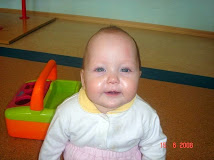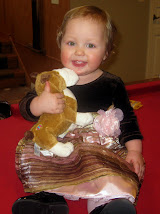I saw this article in Family Circle magazine that I thought was neat:
Happy New Year Around the World
By Emily Fromm
From the American South to the hills of Romania, how children ring in the new year with their parents.
Armenia
Mothers make a special bread for their family, kneading luck and good wishes into the dough before it is baked.
Bahamas
People spend months creating elaborate costumes for the Junkanoo parade. The strangest and most beautiful costumes win prizes.
Bolivia
Families hang little homemade straw or wooden dolls outside their homes for good luck.
Denmark
The Danes throw old dishes at the doors of friends' homes for good luck. Finding a big pile of broken dishes on the morning of January 1 means you have lots of friends!
Ecuador
Families celebrate "Año Viejo" by stuffing old clothing with newspaper and firecrackers, much like a scarecrow. At midnight, each family sets its dummy ablaze, representing the departure of the old year.
Greece
Parents fill their children's shoes with presents at night. They tell the little ones the gifts are from St. Basil, who was known for his kindness and generosity to children and the poor.
Japan
The Japanese decorate their front doors with pine branches and bamboo to bring health and long life. They may also add fans, seaweed, or ferns for happiness and good luck. Children are given small gifts of money called otoshidamas. At midnight, bells and gongs are rung 108 times to chase away 108 troubles, and people laugh to drive away the bad spirits.
Portugal
In the north, children go caroling, singing old songs called Janeiros from home to home, where they are given sweets and coins.
Puerto Rico
Children throw pails of water out the window at midnight to rid their homes of evil spirits.
Romania
Children wish people a happy new year by touching them lightly with a bouquet called a sorcova, which consists of twigs from an apple, pear, cherry, or plum tree to represent fertility, health, and purity. Traditionally the twigs would have been placed in water on November 30 so they'd blossom by New Year's Eve. Today people decorate the twigs with flowers made of colored paper.
Spain
When the clock strikes midnight, people eat 12 grapes, one for every stroke of the clock and for good luck in each month of the new year.
Switzerland
The Swiss let a drop of cream land on the floor on New Year's Day to bring good luck.
The Southern United States (that's us!)
Many Southerners eat black-eyed peas for good luck. Round foods are traditional for the new year in many cultures because circles represent continuity. Black-eyed peas are considered especially lucky because they contain two concentric circles.
Well, that article prompted me to find out how the New Year is celebrated in Russia. This is a summary of what I found:
Russia
When the communists came into power they forbid religious holidays. But Christmas tradition was so strong (the people continued to decorate the Christmas trees in an underhand way) and the government allowed the people to celebrate what was the Christmas holiday now in a different way and at a different time: now as a New Year holiday so long as the religious meaning was eliminated.
Gradually the religious meaning to the holiday has deteriorated leaving the general meaning of the New Year holiday as one for a hope that the new year will be more happy and that all bad remains behind in the old year. The Christmas tree was renamed into a New Year tree. But the non-religious traditions of the Christmas holiday remain: Santa Claus, gifts, dancing around the Christmas tree and happy family times.
Russians do not celebrate Halloween, but at Christmas time people wear different costumes at New Year's parties. In country areas, children dress in costumes and go from neighbor to neighbor and are given candy and treats, much like Halloween. The children will dance and sing when they visit the neighbors. Very often the costumes are sewn by the parents.
New Year's Eve (called New Year's Night in Russia) is a big celebration. There are many people in the streets celebrating. Families with young children celebrate at home just with their own family. Young single people like to go out from home. In the big cities there are many choices: many clubs and restaurants have special programs. The theatres and ballet are also popular on December 31 and January 1. Nobody wants to be alone on this night.
Russia has one more special detail: they have two New Years. The tradition of greeting the New Year twice comes from the beginning of the twenty century. Before the communists, Russia had its own calendar. It was exactly the same as the western calendar, just delayed by two weeks. The new government adopted the western calendar but the Church continued using the old Russian calendar.
Gradually, everyone has forgotten about the old calendar or have stopped celebrating religious holidays. Today, people celebrate New Year's even on December 31 and then some celebrate, or at least remember Orthodox Christmas and then New Year's on January 12 and 13. It is called Old New Year. Old New Year is not celebrated with quite as much "celebration" but TV stations repeat all New Year's programs. Young people, of course, have a New Year party again! Then, after January 13 everybody removes the decorations and Christmas trees. The holiday has come to an end.
We've got our Black-eyed Peas ready for tomorrow! I wonder, if we eat twice as many this year, will we get twice the good luck? Might be worth a try!
The Abraham Family’s Journey to Russia to Bring Home Their Daughter
Subscribe to:
Post Comments (Atom)






















2 comments:
Thanks for sharing all that info about all the different countries celebrations. It's so neat! We don't eat the black eyed peas because I can't stand them so eat some for me!!
Good stuff. Amazing how one period of a godless government can erode such long standing traditions so completely. Makes you wonder what would happen if the same were to ever occur in our country. Yet, in a way it is. So hard to find christmas cards or decorations that have anything to do with Luke chapter 2 in any non-religious store these days.
Post a Comment